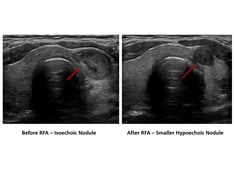Background
The thyroid gland plays an important role in tissue metabolism and development. It secretes thyroxine (3,5,3'5'-tetraiodothyronine), which is abbreviated as T4, and small amounts of 3,5,3'-triiodothyronine, abbreviated T3. Both have systemic effects. Abnormal thyroid hormone levels lead to hypothyroid and hyperthyroid states. Inadequate thyroid hormone during development leads to congenital hypothyroidism (also known as cretinism) with associated irreversible brain damage.
Pathophysiology
Thyroid hormones regulate protein synthesis by affecting gene transcription and mRNA stabilization.
Hyperthyroidism
In hyperthyroidism (ie, thyrotoxicosis) increased thyroid function leads to increased cardiac output at rest and after exercise but to decreased muscle bulk and function. [1, 2]
Muscle activity shows altered electrical responses, altered energy metabolism, and increased sensitivity to beta-adrenergic stimuli. In a clinical study of experimental thyrotoxicosis, the activity of oxidative and glycolytic enzymes in skeletal muscle decreased by 21–37%. Lean body mass decreases and rate of whole body protein breakdown is enhanced. Thyroid hormones have profound effects on mitochondrial oxidative activity, synthesis and degradation of proteins, sensitivity of tissues to catecholamines, differentiation of muscle fibers, capillary growth, and levels of antioxidant enzymes and compounds. Muscles show contraction weakness and lack of normal contraction potentiation. Patients have lower levels of carnitine.
The central effects of hyperthyroidism are most pronounced in development. Cerebral circulation and oxygen consumption elevate. Studies on rat brain mitochondria show minimal effects. Measurements from rats suggest well-preserved brain iodothyronine homeostasis despite high thyroid hormone levels. Brain T4 and T3 concentrations and brain T3 production and turnover rates do not change significantly. levels of glutamate dehydrogenase and pyruvate dehydrogenase activity in the brain are reduced. Beta-adrenergic binding sites in the cerebral cortex are increased and gamma-aminobutyric acid (GABA) binding sites are decreased. Brain levels of serotonin, 5-hydroxyindoleacetic acid, and substance P are altered. Native pain sensitivity and number of opiate receptors are increased. Thyroid hormones affect myelination, therefore increased levels lead to oxidative damage to the myelin membrane and/or the oligodendroglial cells.
Hypothyroidism
In hypothyroidism, muscle contraction and relaxation are slowed while duration is prolonged.
The amount of myosin ATPase decreases. Slowing of release and reaccumulation of calcium in the endoplasmic reticulum may decrease relaxation. In peripheral nerves, segmental demyelination has been observed with decreased nerve conduction velocities. Patients develop polyneuropathy with loss of reflexes and weakness. Decreases in vibration, joint-position, and touch-pressure sensations also are seen.
Thyroid deficiency can impair hippocampal neurogenesis, differentiation, and maturation in developmental and adult rat brains, suggesting a similar mechanism in humans. Hypothyroidism changes synaptic transmission and plasticity in area CA1 of the hippocampus, which, in turn, may be the mechanism that leads to impairment in learning and memory. [3]
Epidemiology
Frequency
Thyroid disease is common in adults. An estimated 20 million Americans have some form of thyroid disease. According to the American Thyroid Association, more than 12% of the US population will develop a thyroid condition during their lifetime. [4]
Women are five to eight times more likely than men to have thyroid problems. [4] One survey found the prevalence of hypothyroidism to be 1.4% in adult females and 0.1% in adult males. The prevalence of Graves disease, a hyperthyroid condition, is 1.9% in females and about 0.19% in males. Peak age incidence is in the range of 30-50 years. Congenital disease occurs in 1 per 4000 neonates in North America and Western Europe. This is seen more frequently in areas of iodine deficiency.
About 1 billion people are at risk for iodine deficiency disorders. Endemic goiter is most the common manifestation and has a varying prevalence. In communities with severe iodine deficiency, prevalence is 5–15% but can reach 100%. This situation occurs in developing countries.
Race-, sex-, and age-related demographics
No race predilection is known.
Thyroid disease is more common in women, but men also are affected. [4]
Thyroid disease is most common in adults aged 30–50 years, but all age groups are affected. Cretinism and neonatal myxedema manifest in the intrauterine/perinatal period.
Prognosis
Prognosis is generally good, since most symptoms are reversible with correction of the underlying problem. Neurologic complications are seldom fatal.
Congenital complications of iodine deficiency lead to cretinism and neonatal myxedema.
Untreated myxedema may lead to myxedema coma and eventually to death in children and adults.
Severity of symptoms of thyroid disease varies with the degree and duration of the deficiency.
Some degree of myopathy is found in about 50% of thyrotoxic patients.
Thyroid storm is an emergency requiring rapid therapy to prevent death.
Although now uncommon, postoperative thyroid disease can be seen.







